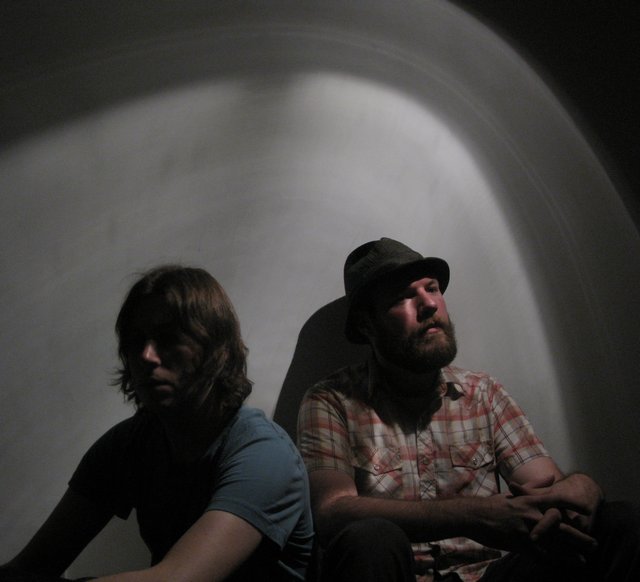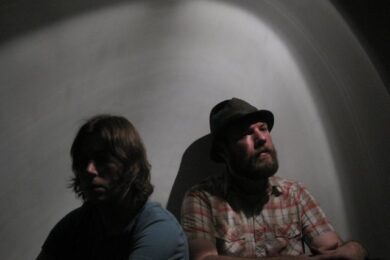Brendon Anderegg and Koen Holtkamp, better known as Mountians, have created quite the sonic stir since their eponymous debut album was released in 2005. Each with respective solo projects to their name and a joint record label venture in the form of Apestaartje, their collaboration as Mountains has garnered them underground acclaim around their adopted home town of Brooklyn with their fusion of minimalist electronica, serene samples, blissful acoustics and DIY recordings.
Their latest release, Etching (Thrill Jockey Recordings), was recorded in real time, and opens up their composed aural calm as a preview to their European tour that starts October 31 in Dublin. Ahead of their London show at the Slaughtered Lamb, The Quietus caught up with Koen to see what was behind the ether of their music.
How did you both meet and unite over this style of music?
Koen Holtkamp: We’ve been friends since middle school. We initially came together because of shared interests in skateboarding and visual art. We ended up going to the same art school in Chicago and both kind of gravitated towards the sound department. Mountains started a few years after that when we were both living in Brooklyn and wanted to start a more live oriented project after focusing mainly on the studio for a few years.
I’ve been listening to your albums Choral and Etching, and I have to admit, I got pretty lost within them – in a sense of depth and journey. Is this something that you set out to do? Does your music depict anything in particular or is it up to the listener to decide?
KH: We have a tendency to shift in dynamics from more quiet intricate moments to more dense and over saturated at times, going from pulling the listener in to filling the space with sound. A certain kind of linear development. Generally the music we make tends to have a gradual pace and focus on detail; we try to keep it open-ended enough for the listeners to come up with their own interpretation.
Do you use your music as a vessel for your own mind’s travel?
KH: This is not necessarily how I would define it but I do certainly hear sounds in my head and enjoy trying to recreate them.
And your record label Apestaartje: is there meaning by the name Apestaartje?
KH: Apestaartje means ‘little monkeys tail’. It’s the nickname the Dutch use for the @ symbol. Symbol to identify a location, a label being a location for music. I’m from The Netherlands originally and wanted to include something from my background.
It reads as if you never intended to reproduce what you created collaboratively on a live scale until you came out under the name out Mountains. Is this the case?
KH: Yes. Mountains was conceived for live performance. We’d done mostly studio-oriented work up to that point and when we tried to recreate these pieces live it always felt like there was something missing. So Mountains was about creating pieces specifically for performance. The idea to make records came later.
How does the live set work? How do you recreate what is on record in a live setting? Or is it a different concept?
KH: It’s backwards. We loosely compose a piece to be performed. Then we play it for a tour or certain number of shows refining it a little each time. When we feel like it’s reached a certain point we record it and then generally do not perform it again. So we never really play the pieces from our records by the time they’re out.
You live in Brooklyn, but there is a great sense of nature within your music. How does your music reside in the verve of the natural world considering your surrounds? How do you go about getting the samples?
KH: I don’t see our music as reactionary but perhaps it’s an escape for some people and I’m ok with that. Neither of us grew up in a particularly urban environment so I think our sense of space comes from somewhere else. In terms of the field recordings we generally just make recordings for fun when we hear something we find interesting and then some if it works it’s way into the music.
What is it about the blend of acoustic and experimental electronic music that draws you to it? How do you get the balance?
KH: It’s a blend we were naturally drawn to. The acoustic instruments have such a rich overall sound and electronics have such a diverse range of manipulation possibilities. We spend a lot of time on the sound of each minor element.
Have you ever considered collaborating with a vocalist? Would you use it lyrically or as another instrument? Is there a message in your music already?
KH: If it were the right vocalist. We’re planning to have some friends contribute to our next record so I think they’ll be some surprises, but I’m pretty sure that will not include lyrics.
Where do you even begin in starting a track and finishing? Do you already have a vision with the way it travels?
KH: Usually we’ll improvise on a certain tuning and slowly we develop that into more specific parts.
Where does your musical background come from? Who/what is it that influences your sound?
KH: My musical background is mainly as a listener. I had been working with sound for a few years but I didn’t start playing music until my early twenties. Brendon has been playing various instruments as long as I’ve known him.
Etching is a real time recording: how is it in producing the album? Again, did you have a vision at the time? Was it more experimental and free forming?
KH: It’s basically a recording of one of our practice sessions for a tour we were about to do. We record pretty much all of our sessions and this was our favourites so we sold it as a tour CDR at some shows in the US. The response was really positive so we thought we’d do a limited vinyl release to represent this phase of the band on a slightly larger scale.
Your sound is quite cinematic, and not necessarily something aural – something visual. Have you ever thought about applying what you do to the screen? Something visual?
KH: Brendon has done soundtracks for several pretty awesome documentaries in the last couple years. I made a video out of footage shot between shows when we were on tour and we’ve performed to that a few times. It’s an abstracted road movie of sorts.
There is a great deal of space and freedom in your orchestrations. How do you avoid adding too much, yet still create such texture?
KH: We spend a lot of time on our overall sound. I think the fact that the two of us play a lot of similar instruments helps us achieve a full but detailed sound. We use a lot of layering, sampling ourselves, building up dense layers of sound and sculpting them via filters and other electronics in real time. Most of our pieces are fairly gradual. Spending time with something tends to give it more definition.
What can the readers expect from your live performance on your new tour?
KH: It’s our first set without computers… a bit more raw, but I think it still really sounds like us. We’ve only played it a few times so we’re pretty psyched to try it out in some different spaces. Other than that we have some touring and probably another record coming out next year but that’s all still in the works.
Catch Mountains live this Thursday, Nov 5 at the Slaughtered Lamb, in London



